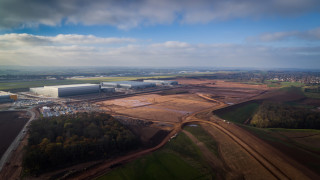Winvic is usually associated with above-ground structures; it’s a specialist in sheds, warehouses and student accommodation. But one of the firm’s biggest projects to date also has the distinction of being one of Europe’s biggest earthmoving projects of recent years.
The Segro Logistics Park East Midlands Gateway (EMG for short) is an enormous new development near East Midlands Airport that will offer up to 560,000 sqm of warehouse space on a site covering around 700 acres. The client is Segro (formerly Slough Estates) and Roxhill Developments.
With its own rail terminal (the Strategic Rail Freight Interchange, or SRFI) for the exclusive use of freight traffic, the scheme involves extensive improvements to the road network in the immediate vicinity of the site - which has itself been levelled and landscaped to accommodate the built development.
Mark Skelton, Winvic’s project manager on the EMG says that the challenge on any major earthmoving project of this kind is “will it balance?” It’s always the aim to redistribute material around the site rather than have to dispose of large volumes or import more.
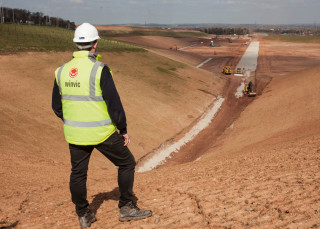
And this is a truly massive earthmoving job. “It’s way over five million cubic metres in total,” says Skelton. “And the question here was whether we’d have enough good quality material to build on. We needed a 95% compaction and 5% void,” he says.
The actual earthmoving has been undertaken by Collins Earthworks, one of the UK’s largest groundworks contractors, which arrived on site in early 2017 and is now in the very final stages of its work on site.
Collins was awarded two contracts. The first, and largest, of these was the £16m contract to clear the site, demolish existing farm buildings and carry out bulk earthworks to create the plateaus upon which the five massive distribution sheds are being built.
After clearing old buildings, trees and hedges, Collins commenced stripping of the topsoil following a sequence designed to minimise water run-off. Half of the earthworks filling is incorporated into a large screening bund, accommodating the surplus topsoil and lower-grade subsoil, which screens the site from the neighbouring village of Lockington.
The second contract, worth around £3.5m, involved highway improvements alongside the M1 motorway between junctions 24 and 24a where a new embankment has been formed. The A50 eastbound now has a direct sliproad onto the M1 southbound.
Construction of the new A50 embankment required the diversion of the Derwent Valley Aqueduct, a high-pressure water main taking water from Ladybower reservoir in the Peak District down to Leicester. Following installation of the new pipeline, Collins used vibration-less compaction methods to backfill the excavation, thus minimising the risk of damaging the pipe.
A significant part of the embankment’s footprint extended across an old landfill tip. Here, Collins saved time and money by avoiding the need to excavate the made ground and re-engineer the soil. Instead, Collins provided a stone mat for geotechnical engineer Hydrock to come in and use its high energy impact compaction system to consolidate the existing ground.
This effectively dealt with any settlement and allowed the embankment to be built without the risk of further movement.
Accurate estimates of the quantity of materials involved in a major earthmoving project are essential, says Skelton. “Everything balances in theory…but it’s always a risk when you get towards the end of the earthmoving phase.
“On this project, it’s worked fairly well. Because of the variable quality of the soil, we had to use lime stabilisation to improve some material, but we could only do this in locations where we wouldn’t be building on top. We were working with high-sulphate soils and there can be issues with heave when you use lime in this type of soil,” he says.
Completion of the EMG earthworks has been successfully achieved using modern, but conventional, design techniques. Winvic is now hoping that future earthmoving contracts will be easier and more straightforward to design and execute thanks to its newly-acquired BIM (Building Information Modelling) Level 2 capability and its Centre for Innovative Construction (CIC).
Located in a separate building alongside the contractor’s head office at Moulton Park, Northampton, the CIC comprises a virtual reality ‘BIM cave’ with a 125” screen for 3D model viewing and an interactive meeting room allowing real-time design changes on 86” smart screens as well as a training space that Winvic hopes will “enable 360 degree education across the business and the supply chain”.
The new facility marks a major step forward for the company, which since 2014 has been working towards BIM Level 2 certification. It finally achieved this in December 2019 following a BRE audit the previous month.
The company has been offering industry-standard BIM Level 2 to clients for several years, first demonstrating its capabilities on industrial facilities for John Lewis and Waitrose around five years ago.
“Until this year, we had always carried out BIM-enabled projects in partnership with a specialist consultant,” explains Arun Thaneja, Winvic’s BIM lead manager. “Now we’re Level 2 certificated, we can carry this out in house,” he adds.

Although BIM Level 2 became mandatory on all public sector projects in 2016, government enforcement of the requirement has been patchy, as has adoption by the industry at large. Client buy-in is crucial to the promotion and use of the technology since, according to Sanderson, the benefits to the client are potentially huge.
“Time, cost, efficiency – even marketing – can all benefit from utilising BIM,” says Sanderson. “The ability to visualise the project accurately pre-construction is immensely valuable to the whole supply chain,” he adds.
As an example, he cites the UK head office of a retail client, which Winvic is in the process of completing. In preparation of the fit-out phase of this job, Winvic invited the client team to its new CIC suite to finalise the internal finishes.
Using VR technology, the client’s team navigated through a virtual environment of the facility and were able to make significant changes to the finishes in the morning and sign them off in the afternoon.
“Visualisation, pre-construction, enables faster, more accurate integration of the various design elements,” explains Thaneja.
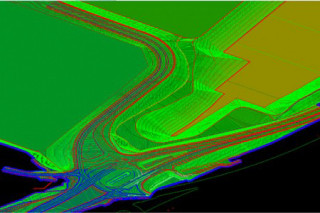
Because BIM ensures that all parties can share the same information in real time, the elimination of clashes is made much easier and problems are preempted before they become a reality on site. “You’re averaging 60,000 clashes on a typical major project,” says Thaneja, “and it can take up to six weeks to get them down to the hundreds.” Using BIM, you can eliminate the majority of fundamental issues before you’re even on site.
To date, BIM has been primarily employed in the construction of large buildings where its ability to clarify the complex interaction of different elements – structural frame, cladding, M&E etc – is a major benefit. But BIM has also been applied in the infrastructure sector (notably in bridge construction) and later this year, Winvic will be starting work on two large projects that use BIM to design and execute the bulk earthmoving element.
“We’ve already modelled the projects and the BIM model contains all the technical information on the proposed surfaces, levels and earthworks volumes,” says Thaneja.
Information such as existing underground services, topographical survey data and engineers’ finished levels is fed into the BIM model which can interface with the machine-mounted geo-positioning technology employed by the earthmoving contractor to optimise groundworks.
The software employed in the machine control systems is different from the Autodesk Revit software used to build the BIM model, but Winvic’s BIM specialists have found a way of making the two systems compatible.
“Everything is modelled in Revit and uploaded on a cloud-based platform. Each BIM file is updated on a fortnightly basis,” says Thaneja. But this can’t be done using data from the earthworks contractors’ model.

“As long as I can export an IFC file, we can integrate it into the model,” he adds.
The two projects about to get underway in June this year will use this new system to integrate the earthworks subcontract packages with the project BIM models. Although the schemes cannot be identified at this stage, Thaneja confirms that one is a major development with multiple commercial units and extensive associated infrastructure on a greenfield site alongside a motorway.
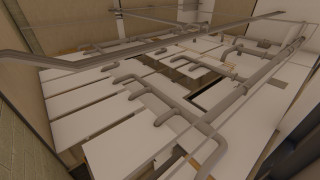
With the addition of its new CIC, Winvic is now poised to enhance and further develop BIM, VR and other emerging technologies, says Sanderson. He believes that the company is setting the pace and is well ahead of its main competition.
On the EMG project, there were huge amounts of material for Winvic to move – up to 30,000m3 per day. On a project like that, a 10,000 tonnes discrepancy is nothing in the grand scheme of things – until, as Skelton says, you get near the end of the job.
While this didn’t occur on the EMG, a shortfall in site-won fill means importing expensive material; conversely, a surplus needs to be exported off-site for disposal – also at significant cost.
Using BIM to design and plan the earthworks will put an end to such uncertainties, hopes Winvic. And as a result, it should deliver savings in time, money – and even carbon emissions.
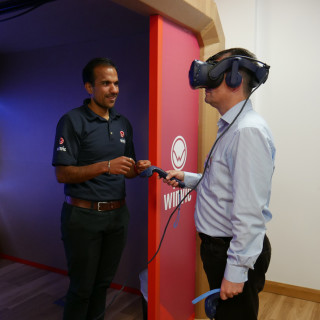
Segro EMG vital statistics
Winvic was appointed by Roxhill Developments and Segro to build highways infrastructure and undertake extensive earthworks in fulfilment of Contracts 1 and 2 for the rail freight terminal and distribution park adjacent to East Midlands Airport.
• Six million sq ft of development plots for storage and distribution warehouses
• Six million cubic metres of plateau, screening and topsoiling earthworks
• Two-metre rise in the level of a newly-laid section of the A45

• New rail freight terminal to accommodate up to 16 trains a day
• Earthworks cut up to 25m below existing level for rail freight terminal
• 7km private rail link to Castle Donington branch freight-only line
• 105,000m3 of earth moved in any one week at peak of the earthworks programme
• 65 pieces of machinery operating on site any one point
• 126,040m2 of new surfaced pavement
• 163km of new services
• 1km of new 1m-diameter ferro concrete pipework in the diversion of Derwent Valley Aqueduct, serving 600,000 customers in the East Midlands
• Over 300,000 tonnes of aggregate
Collins’ earthmoving packages
Contract 1
On site: January 2017 – end 2019
Earthworks package value: £16m
Total development area: 2,340,000m2
Topsoil strip: 610,000m3
Cut to fill: 5,100,000m3
Total landscaped areas: 846,400m2
Aggregate import: 150,000 tonnes
Works:
• Site clearance
• Demolition of farm buildings
• Bulk earthworks for plateaus, access
road, A453 junction, basins, rail embankment and bunds
• Lime stabilisation
• Aggregate import for infrastructure
• CBGM beneath carriageways
• Compound
• P-way track installation
• Reinforced earth embankments
• Landscaping
Contract 2
On-site: April 2017 – present
Earthworks package value: £3.5m
Cut to fill: 174,000m3
Aggregate import: 44,000 tonnes
Works:
• Site clearance
• Diversion of Derwent Valley
Aqueduct
• Demolition of A50 structures
• Bulk earthworks for the new
embankment, flood compensation area and junction improvements
• Lime & cement stabilisation
• Aggregate import
• Compound
• Reinforced earth embankments
• Landscaping
This article was first published in the March 2020 issue of The Construction Index magazine.
UK readers can have their own copy of the magazine, in real paper, posted through their letterbox each month by taking out an annual subscription for just £50 a year. Click for details.
Got a story? Email news@theconstructionindex.co.uk

